#like. they could be forced to go to selected isolated areas to fight. the stakes would be The Same
Text
The Walking Dead: Bounty (9x11)
Oh, man, that was actually quite a good episode.
Cons:
I want to be on board for Ezekiel and Carol, but sometimes it just makes me roll my eyes. I get it - surviving isn't enough, you really have to live. That's the theme of this episode, and it's an important one for a show like this to dwell on. But risking four people's lives over a projector light so that the Kingdom can play movies at the festival? I hate to be a spoil sport, but someone could have died. Would it have been worth it for the Kingdom to lose its leader, or for Jerry's baby to lose its father? Come on.
Henry is essentially Carl 2.0 at this point, and while I don't uniformly hate every scene Henry is in anymore, I will say that Carl was at his most annoying when he was being dreamily optimistic, and Henry isn't an improvement on that. This show seems to think we need a wide-eyed innocent to remind the hardened adults what they're fighting for. I'm not so sure that character trope has ever been pulled off without being incredibly irritating.
Pros:
So, like I said, the theme here is about living vs. surviving. It's a pretty clear dichotomy, and it's one that this show has already tapped into plenty of times, but here we're seeing it as a community vs. Whisperers dichotomy as well, and there's actually a lot of really great material in support of this theme.
First of all, I will admit that the flashback scene at the beginning of this episode hit me right in the feels. Ezekiel and Carol learn that Jerry's girlfriend is pregnant, and they celebrate that. We also see Jesus and Tara come to drop off some supplies, and a copy of a constitution that is meant to be signed by all of the nearby communities. Due to whatever mysterious thing happened in the six year time jump, Alexandria has obviously pulled out of talks for such a union, but Ezekiel keeps the constitution, and maintains hope that one day it will be signed. Seeing Jesus was a punch to the gut, and a good reminder of what's at stake, and what we have to gain, as well as lose. Ezekiel can be something of a ridiculous figure, sure, but he's also brave to be so continually optimistic.
That's actually something I'll say for Ezekiel and Carol's plot thread over all: it positions optimism as brave and heroic. Sure, risking multiple lives for the sake of screening some movies is maybe a little extreme for my particular taste, but the message is clear. What exactly is the point of surviving if we can't find joy in life?
In Hilltop, the Alpha of the Whisperers demands that Lydia be returned, in exchange for Alden and Luke. Daryl doesn't want to give up the poor girl, but eventually it's decided that this is the only option. Henry reluctantly agrees, only when Lydia says she wants to go back. However, as the episode ends, we see that Henry has sneaked off to bring Lydia back, and Daryl goes out after him, followed by Connie, who insists that she can't live with what they've done to Lydia.
This was a powerhouse episode for Daryl. You've got this guy who has been living in the woods, isolating himself from the world around him since the loss of Rick. He believes in the communities, but he doesn't necessarily believe in his own place among his friends. And here he is, trying to be a moral compass for Henry, trying to save Alden and Luke while not giving Lydia up, suddenly thrust into a leadership position that falls to him so naturally, but that he's tried to reject. Hardship can force people together, and I think maybe that's what's happening here a little bit. Daryl might be forced to become part of a community again by virtue of this new external threat.
The best scene in the whole episode for me was Connie saving the baby. The Whisperers are outside of the gates of Hilltop, and the crying of an infant is drawing a hoard of Walkers towards them. The mother of this infant sets the baby down, ostensibly to leave it to be eaten by the Walkers. Why? Well, Alpha explains that they are all animals, and that this is just natural selection. Connie, who is hiding in a cornfield on the edge of Hilltop, is able to see Luke. His hands are tied behind his back, but he manages to sign to her to tell her about the baby. She runs forward and grabs the infant, then has to make her terrifying escape through the corn field and back to safety.
There are two levels on which this scene worked for me. The first, more superficially, is that I'm always pleased when this show can come up with a new scary scenario with the Walkers. Having a Deaf woman holding a baby running through a tight, enclosed space... that was certainly a new and terrifying scenario. I was on the edge of my seat, even if I was pretty confident that Connie and the baby would get out.
The second level is thematically - saving that baby was an incredibly risky thing to do. Caring for another infant isn't going to be easy, and while Hilltop is doing okay, resources are not unlimited. But of course Connie risks her life to save a baby. Of course Luke tells her where the baby is. And of course multiple people in Hilltop create a ruckus to try and divert the Walker hoard away from their desired snack. This is a community of people who don't even hesitate when it comes to saving a child's life. Throughout the course of this show there have been plenty of evil people taking advantage of the harshness of the apocalypse to do horrible things to other people. But the inherent goodness of humanity is still on display. A baby's in trouble? Every decent-minded person in the area stops what they are doing and fights as hard as they can to save that baby. It might seem like an obvious thing for our heroes to do, but I think it's still important to clearly state this philosophy in opposition to what we're seeing from the Whisperers, and what we've seen from so many other antagonists over the years.
I think that's all I've got for now. I'm excited to check back in with Michonne next week. I feel good about this half of the season. Precocious little Judith turned me off from the time jump stuff at first, but she's playing a minimal role, and there's a lot of stuff here that I find really interesting. I'm particularly loving the focus on Daryl as a character, and I hope we keep up with that.
9/10
4 notes
·
View notes
Text
SUMMARY
Former NYPD Captain Dewey Wilson is brought back to the force and assigned to solve a bizarre string of violent murders after high-profile magnate Christopher Van der Veer, his wife and his bodyguard are slain in Battery Park. Executive Security, the private firm employed by Van der Veer, blames the murders on terrorists, but knowing that the victim’s bodyguard was a 300-pound Haitian with voodoo ties makes Wilson skeptical. With pressure to solve the case coming from both the Police Commissioner and the Mayor, Wilson is partnered with criminal psychologist Rebecca Neff.

Elsewhere, in the South Bronx, a homeless man explores an abandoned church that is scheduled to be demolished by Van der Veer’s development company. He is killed by an unseen monstrous being. Wilson and Neff investigate his murder. At the church, apparent sounds of a baby crying lure Neff up to the bell tower. Wilson follows her but does not hear the crying; once Neff is separated from him, he hears a wolf howl. He goes up after Neff and drags her to safety. Later that night, a bridge worker is apparently murdered by the same creature.
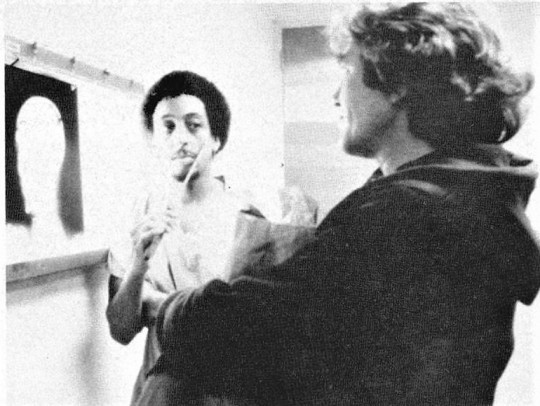
Coroner Whittington discovers non-human hairs on several victims and consults a zoologist named Ferguson, who identifies the hairs as belonging to an unknown subspecies of Canis lupus. Ferguson compares wolves to Indians. Inspired, Wilson finds Eddie Holt, a militant Native activist he arrested some years previously, working in construction. While Wilson interrogates Holt on top of the Manhattan Bridge, Holt claims to be a shapeshifter, which implicates him as the killer. Wilson opts to leave Holt alone and tail him that night.
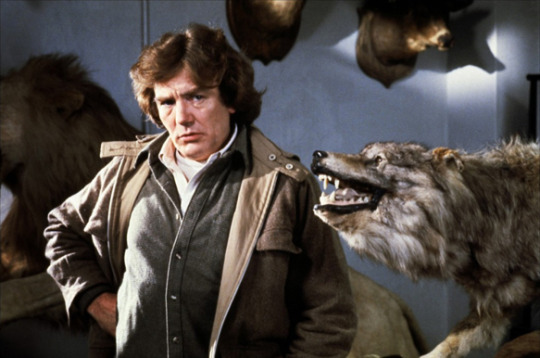
Following animal clues, Ferguson goes to Central Park, where the killer ambushes him in a tunnel. Wilson spends the remainder of his night with Neff where they have sex. The following morning, a man in a jogging suit rides Ferguson’s motorcycle past Wilson as he leaves Neff’s apartment. Whittington and Wilson stake out the church, armed with sniper rifles and sound equipment; after Whittington almost blows his ears out by opening a beer can near a parabolic microphone, an animal that appears to be a wolf kills him. Meanwhile, Executive Security apprehends a “Götterdämmerung” terrorist cell in connection with the Van der Veer slaying.
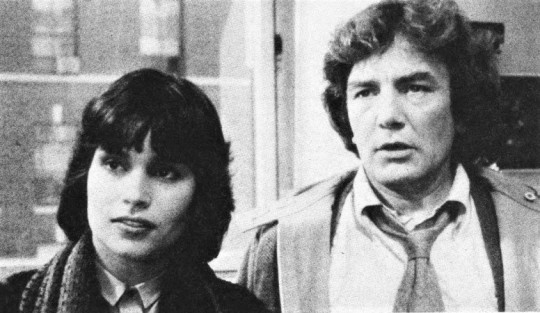
A traumatized Wilson escapes the church and finds himself at the nearby Wigwam Bar, where Holt and his friends are drinking. The group of Natives reveal the true nature of the killer as “Wolfen”, the wolf spirit. They explain that the Wolfen have extraordinary abilities and “might be gods”. Holt tells Wilson that he cannot fight the Wolfen, stating: “You don’t have the eyes of the hunter, you have the eyes of the dead”. The leader of the group, the Old Indian, informs Wilson that Wolfen kill to protect their hunting ground. Wilson resolves to end his involvement in the Van der Veer case but he, Neff and Wilson’s superior, Warren, are cornered on Wall Street by the Wolfen pack. Warren is decapitated while Wilson and Neff flee.
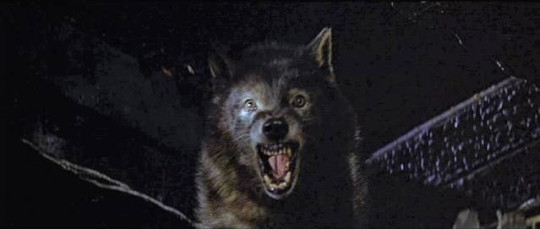
Wilson and Neff are cornered in Van der Veer’s penthouse by the pack, led by its white alpha male. Wilson smashes the model of the construction project that threatened their hunting ground, trying to communicate that the threat no longer exists and that he and Neff are not enemies. The Wolfen vanish just as the police barge in. Wilson claims the attack was made by terrorists. In a voiceover, Wilson explains that Wolfen will continue preying on weak and isolated members of the human herd as humans do to each other through class conflict. Wolfen will continue being invisible to humanity because of their nature; not that of spirits but predators, who are higher on the food chain than humans. The last scene is Eddie and his friends looking at the city from the bridge.
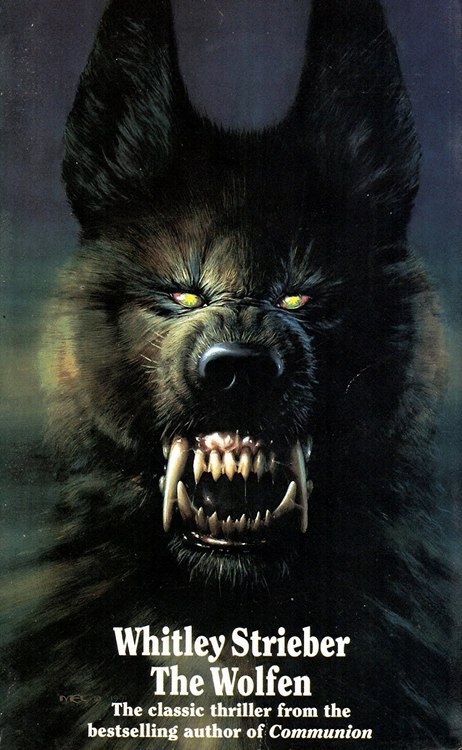
DEVELOPMENT/PRE-PRODUCTION
In adapting The Wolfen, director Michael Wadleigh and co-screenwriter David Eyre decided to expand freely upon Whitley Streiber’s original prose. Streiber’s novel worked well as a “police procedural,” but they felt his storyline needed to become more impassioned for celluloid. And, although the basic plot remains the same, Wadleigh wanted to make his film more “socially relevant.”
“What appealed to me about Wolfen was its underlying allegory about nature,” Wadleigh says. “I wanted to play that up much more in the film. The genesis of the Wolfen’s culture is that when white man first came to America, he came as a farmer. His two basic enemies were the hunting tribes: wolves and Indians. The wolves and Indians were simpatico, and accommodated each other. White farming man wiped them, the forest, and the great American buffalo out. We reduced the wolf population from a high point of two million to fewer than one thousand. What’s fictional in our screenplay is that the wolfen are the product of biological/artificial selection. When we destroyed the original wolf population, only the smartest survived. The bright ones got even smarter. Their forests were all gone, so they moved into the new wilderness: the slum areas of the major cities. For survival, they hunt at night. For protection, they only eat people that our society doesn’t give a shit about, the inhabitants of the slums. These people are never missed, so their murderers are never looked for.”
A possible hole in Wadleigh’s concept is that since his wolfen have a special understanding with Indians, they would probably also recognize impoverished blacks and Puerto ricans as “brother” victims of modern society.
“Being humanitarians or ‘wolfitarians, explains the director, “as they also are in Whitely’s book, the Wolfen only take people who are essentially ready to die. It’s almost an eastern philosophy of euthanasia. They would not kill a healthy black man. They would kill an ancient derelict who was ready to die. First, the Wolfen would check him out very carefully to make sure he wanted to give up his life. The Wolfen have a tremendous empathy for the people they kill.”
By putting the Wolfen on the same level as Indians, Wadleigh seems to be reducing Indians to yet another stereotype.
“I avoided that by making our Indians real,” defends Wadleigh. “I’ve lived with them as neighbors in Wyoming, so I know what they’re like. Indians are not the kind of preachy, sanctimonious crowd that so often gets horribly portrayed in films. The Indians that I know are incredibly clever and have a great sense of humor. What happens early in Wolfen is that Wilson is led to believe that Christopher VanderVeer’s murder might have been done by radical Indians. He goes to see Eddie Holt [Edward James Olmos], whom he’s busted before, where he’s working on fixing something on top of the Manhattan Bridge. At the foot of the construction site, Wilson tells an old Indian to bring Eddie down for questioning. The Indian says, ‘Screw you. You want him, go on up there yourself.’ Wilson precariously makes his way up to the bridge by walking up its suspension cable. When he gets to the top, there’s a great dialogue between him and Holt that I ripped off from things I’ve heard Indians say in real life. Wilson asks, ‘Are you in touch?’ Holt answers, ‘With what, my mother?’ Wilson says, ‘No, with mother nature.’ Holt says, ‘Sure. I swim like a fish and screw like a bunny.’ Olmos, after people see him as Holt, is going to be a big star. People will be left with envy of Indians. It’s a whole other subculture that they’ll want to get into. It’s not Eddie’s speeches they’ll remember, but his being.”
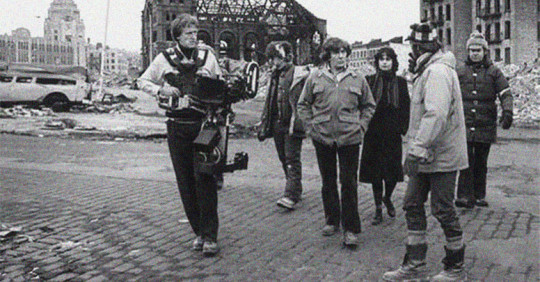
Olmos enhances the performances of movie veteran Albert Finney as Wilson. Finney, a two-time Academy Award nominee, decided to make Wolfen his first film in five years due to his love for the character” and the project.
“David Eyre and I changed the Wilson character from the book,” reveals Wadleigh. “Now, he’s a cop in his forties who’s the best homicide detective around. What he’s begun to realize, however, is that his professional life is a fraud. He’s a hunter for society but he only stalks small game. The real criminals, the people who control society, are never brought to justice because they set up the law to protect themselves. Wilson’s become much more of a 1960s type of character, which allowed me to work out a lot of my own personal philosophy. I was thrilled when Albert decided to play him, because in my opinion, he’s one of the greatest living actors.”
A less significant character alteration was changing Wilson’s first name from the novel’s George to Dewey.
“That was for a clever line of dialogue that is representative of my bad jokes and corny puns that riddle the film,” Wadleigh grins. “Rebecca Neff is sitting in Wilson’s office and she looks at his coffee cup and says, ‘Dewey.’ He says, ‘Yeah. I was named for one of Donald Duck’s nephews. I was the middle duck.’I mean, what could we have done with the name George?
“There’s another scene that’s been driving people up the walls. It occurs towards the end of the film when the main characters are staking out the Wolfen in the South Bronx. Wilson’s up in one building and Gregory Hines, as the black medical examiner, Whittington, is in one across the street from him. Wilson is trying to call Whittington on his walkie-talkie and he isn’t answering. Wilson starts panning his infra-red sniper scope-the way in which man sees at night-over these burned, wrecked buildings and doesn’t see anything. The audience will become convinced that Whittington’s been offed. Finally, Wilson’s scope comes upon one window where Whittington is standing with his pants down, mooning him. Wilson says over the walkie-talkie, ‘Very funny. Whittington turns around with a big shit. eating grin on his face and says, ‘Black moon over Manhattan.’ Some of the executives at Orion were saying. “What is mooning?’ I told them, “Don’t worry about it. The moviegoers will understand.’ The scene is doubly funny because of the legend of the full moon and werewolves. In fact, I suggested to Orion that part of Wolfen’s logo could be Gregory Hines’ ass. I don’t think that they took that too seriously, though.”
Wolfen’s cast enjoyed Wadleigh’s offbeat sense of humor. But since the director had previously only been a documentarian and this was his first dramatic movie, he might have run into trouble with his cast whenever he suggested to them that they modify elements of their portrayals.
“We avoided those clashes,” Wadleigh states, “because we were all united in believing that we were there solely to do the best we could. Every one of the actors got involved to the extent that they did for two reasons: their character and the film. They opted for a personal choice. They always made sure that not only was something that they were doing going to be good for their part, but for the picture as a whole as well. Since they had a basic respect for the project, they weren’t dealing with glorifying my ego, but Wolfen itself.”
PRINCIPAL PHOTOGRAPHY/LIVE WOLVES
When it came time to use actual wolves, Wadleigh ran into difficulties because he was shooting on location. The majority of Wolfen was shot in New York City, utilizing Staten Island, Central Park, the New York Stock Exchange, the Manhattan Bridge, the Fulton Fish Market, Battery Park, the South Bronx, and the historic sound stages of Queens’ Astoria Studios.
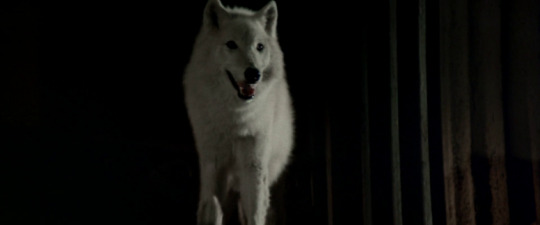
“Not only did we have to fence in the area where we were shooting our wolf scenes,” he discloses, “but Manhattan sent down police sharp shooters. They were under orders to shoot to kill if the wolves got out of the fenced-in area. The other side-effect of using the wolves was that, naturally the cast and crew were afraid of them. The mythology that the wolf is the devil is absolutely permeated through everyone’s conscious and subconscious. We make use of that in the film by having a church in the Dresden part of the South Bronx. By association, the audience will automatically think that the devil is somehow involved with the murders. The other thing that’s scary about the wolves is that they’re large. We were working with a 150 pound animal that when it stands up has its head six feet and six inches above the ground. What assuaged everyone’s fear was that the wolves are beautiful creatures. Their elegance is disarming. We used that element in the film as well. I think that throughout Wolfen, people will expect that the murderer is going to be a hideous werewolf or Alien-type creature. What they finally see are these gorgeous, noble animals. The audience will wind up with empathy for them.”
Wadleigh avoided the problems normally associated with dealing with animals in movie making by turning to expert trainer George Toth.
“I think we had the best wolves in America,” Wadleigh says. “George raised his wolves so that they think that they’re humans or that humans are wolves. Therefore, they have a respect for us. A very significant point, however, is that a wolf is not a dog. Wolves’ intelligence ranks just beneath the great ape’s, the whale’s, and the dolphin’s. We were dealing with a high powered rifle. You can’t really order a wolf to do anything, you have to ask him. If one of our wolves didn’t feel like doing something, there was no way we were going to force him. Since we were dealing with an animal that was essentially its own person, we had to wait for the mood to do something to hit him which consumed time and patience. In the end, though, they always came through amazingly well.
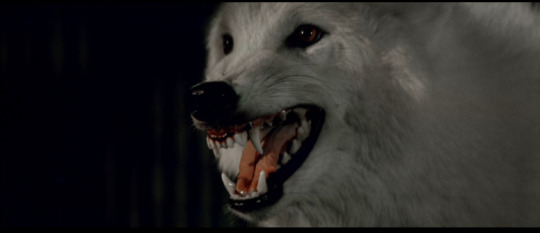
“As good as our wolves and techniques for showing their senses were, though,” Wadleigh continues, “they didn’t allow us to illustrate what I thought was Whitely Streiber’s greatest creation: the Wolfen’s internal thought processes. We solved that problem by introducing Indians to the story. Who better could explain the dignity of the Wolfen and their point of view? The particular irony of the Indians, this destroyed race of people, is that they are the best high steel construction workers in the world and are now building the white man’s great monuments: bridges, the World Trade Center … They, like the Wolfen, look upon the white man with incredible disdain, yet the both of them are forced to live in our great, corrupt cities.”
Michael Wadleigh
Interview with Michael Wadleigh
You’ve expressed frustration in the past that Wolfen has been labeled a horror film. Do you have something against the genre?
Michael Wadleigh: Yes, but that’s not the point. I never thought I was making a horror film. I thought I was making a political thriller about a detective investigating activists who are killing off very rich people, and have a political and social agenda that is still made very clear in the movie. The way I photographed and presented the wolves, they never, ever growled or snarled, because that would demean their intelligence and make them stupid in my view. I wanted to make them this shadowy e presence that was very much in control of the situation, and even more frightening. I mean, I was all for killing everyone in sight! [Laughs] That didn’t bother me at all.
The Baader-Meinhof Gang is mentioned in it, and other terrorist organizations, and even recently, when the Twin Towers went down, a number of people read about Wolfen and said, “That was a film about terrorists.” There were critics who well-recognized the parallels between my film and, as Barack Obama’s ex-minister Jeremiah Wright said, “The chickens coming home to roost.” America had done many things abroad that were against its own ideals, and of course it had been done in the way we treated the American Indians. I don’t think there is anyone who disputes, with hindsight, the fact that we just stole their land and murdered them and drove them out of business-completely unacceptable behavior today. I’m just giving you an example of the anger and injustice that Eddie Holt (Edward James Olmos] well expresses to Dewey Wilson (Albert Finney).
The whole backdrop is what we did to the Indians, and the reason I killed off Van der Veer is also made clear: that his great-great-ancestor reputedly brought the first machine to America—the windmill-and that machine stands for the Industrial Age and the supposedly superior technology of the Europeans that just wiped out the Indians. They really couldn’t compete. I mean, doesn’t that sound right? It was all there in the film.
But you yourself once famously described Wolfen as “a thinking man’s horror film.”
Michael Wadleigh: I don’t recall those words, but if I did, you obviously know what I mean because I just said what I thought of it. Maybe at one point I did say that, but I must insist that my memory isn’t that bad and I always thought this film was a political thriller-and why political? Well, I’ve just explained to you. I mean, we’ve got American Indians vs. white people.
What were the main difficulties for you and co-writer David Eyre in adapting Whitley Strieber’s novel?
Michael Wadleigh: During the discussions I had with [Orion topper] Mike Medavoy, 1 talked about the wolves in terms of Moby Dick—which was not to be pretentious, but just to try to get an idea in there that Ahab was a kind of detective or hunter for his society, so to speak, who was obsessed with tracking down and killing the whale. As most people read Moby Dick, the whale stands for nature and Ahab’s obsession is misplaced, and he goes to his death not realizing it.
Well, I pitched the idea that the character of Dewey Wilson is sort of disconnected from nature, but then gets obsessed with tracking down the wolves. Eddie Holt shakes him up and says, “Well, you’ve pretty much destroyed nature in America, haven’t you? Look at the city look at the South Bronx area that resembles Dresden and the end of civilization. Aren’t you on the wrong side? Why annihilate the last of nature?” And in the end, Dewey quits the police force. He literally, in my screenplay, throws his gun and badge away and says, “F**k it!”
He can no longer uphold the values of a society that he feels is unjust, and now begins to question his own role as a defender of those values and a protector of people like Van der Veer. That’s what I pitched as kind of a way through the piece. Of course, there are no Indians at all in Whitley’s novel, and no political agenda, so you can see that the things I added were very strongly along the lines of a political thriller.
Much was made of the “alienvision” that represents the point of view of the marauding Wolfen. How difficult was that concept to realize?
Michael Wadleigh: I’m speaking for cinematographer Gerry Fisher, Steadicam operator Garrett Brown and myself when I say that we were never entirely happy with that, but we were never too disappointed either. We kept playing around with various things, infrared photography and reprinting the colored layers and so on. Garrett, who not only invented the Steadicam but is considered the best operator by everybody, is 6 feet 8 inches tall and a very athletic guy who can run like crazy. He is also very smart, and so the first thing we got was the terrific Steadicam photography that makes you think there’s a mind behind the point of view, that we are actually looking out of somebody or something’s eyes. Next we added the coloration, the strangeness of the vision, and then we had the soundtrack and sound effects and all of those elements that—so the critics thought were put together well and added up to very intriguing and scary sequences.
Actually, I always thought that Wolfen was set in the future that it was a little bit of a science fiction film as well with the advanced hi-tech security force and the parallel that they were using infrared photography for their remote lie-detection systems. That was all deliberate, to compare nature and technology and have them sort of meeting in the future.
One of the best scenes is right after Gregory Hines is killed by the Wolfen, when Dewey stumbles into the Indians’ local bar.
Michael Wadleigh: Well, that was the scene that I longed for, though it is a bit expositional. Eddie Olmos played the hell out of that, and the other Indians too, who were not real actors. They all did a good job, but Eddie, especially in a few words, conveyed the essence of the scene and then the way they all just laugh it off and so on. By the way, that was a real bar—not that it matters—but for authenticity that was the real steelworkers’ bar where the Indians hung out. We didn’t redecorate it or anything. I guess as a documentarian, I thought that was interesting, and would maybe lend something to it. Whatever was there and whatever they were dressed in, that was it. I’ve never been satisfied by the way Indians are sometimes portrayed in films, but they seem very real in that scene very dignified and eloquent and funny. Eddie had hung out with the Indians for quite a while and tried to get the cadence of how they spoke in that kind of clipped way of using very few words.
They did very good makeup on Finney, and I think he brought a lot of concentration to that scene—but it was slightly recut as well, so I wince a little bit. Nonetheless, I won’t complain. I believe that scene is great, and one can judge that all the general qualities of the film are there.
What was the difference in your version of that scene?
Michael Wadleigh: Uh, let’s not go into that. Let’s be…I don’t want an alibi for anything. I’ll tell you the thing that still most upsets me, which is the marketing of Wolfen in general. I really thought that it could have had the horror film audience because the word would get out, but I also believed it would have captured those people who appreciated the Robert Ludlum sort of thing—a film that was a more of a sophisticated international thriller/detective story—but of course, that wasn’t the advertising campaign at all. All of the wolf material and general treatment that they added brought it more toward what I thought was a simplified horror film-and they thought so too. They thought that if they went that route, it would make more money. As a matter of fact, you may know that Orion was having trouble at the time and was, in my view and I said it at the time, a little bit desperate for a hit. I believe the critics, for one thing, think they made a mistake. They probably could have made more money going the other way. So that’s what I’d prefer to comment on. I only wish that it had gone that way.
The actual look of the Wolfen in your movie has aroused much debate.
Michael Wadleigh: I felt that the film was much more of a nature allegory, and therefore I was never interested in making an artificial creature. What I decided to do was put the Indians and the wolves together as a team, so to speak, and therefore create a new creature by imagining an intimate association and communication between them. An amazing thing that I believe is mentioned in the film is that the Dutch colonists who first settled in New York actually used the same word “wolfen” to describe both the Indians and wolves. They of course knew the difference, but there were quite a few wolves around at that time, and those early colonists denigrated the Indians as savages and really felt they were different from full human beings. They felt that the wolves were so scary and powerful and this fear came out of European mythology as well—that they actually elevated the wolves’ intelligence and lessened the Indians, and in doing so sort of drove them together so that they were pack animals that were wild and ferocious and almost anti-real human beings.
That was the central interesting issue for me, that the Dutch were pushing the Indians and wolves together. Therefore you kind of had a bifurcated personality, and they were after all shape shifters. Well, we put it in the film when Eddie Holt shapeshifts on the beach. You have them sometimes looking like Indians and sometimes like wolves.
Legend has it that you once considered using midgets in masks to portray the Wolfen.
Michael Wadleigh: Never! I can’t imagine where you got that from. That’s outrageous. Ask anyone who worked on the project. Anyone! As you know, we used real wolves, and what separates them from dogs is their elegance and concentration. Those damn things would look at you, and you would break your stare away from them. They had tremendous power and could really stare you down, and it scared the shit out of you. That worked as a strong setup to then go-pow! There’s a shadow, a splash of blood and you are gone! You unsettle the audience by using surreal sound effects, and watching a wolf’s jaws come up into frame and that kind of thing, but I still say that one of [the producers’] huge mistakes was going more animal with them. They should have stayed with the heightened surreal factor I intended, but instead they inserted shots I didn’t do and didn’t approve of, of the wolves growling. I was trying to convince the audience that these creatures had not only a powerful physique capable of delivering instant death, but an elevated intelligence—not to telegraph their presence to their victims ahead of time! I don’t want to go on about it, but I still feel very strongly about that one.
Was it difficult shooting with real wolves?
Michael Wadleigh: Not at all, except that the paranoia of human beings is extreme. I mean, wolves are presented in all the movies as evil, and we have associated them in our mythologies with the devil and all of that kind of thing, but there are relatively few instances of a pack of wolves wiping out a human being. You should find some of the production stills from when we filmed the wolves in New York City. They had like a dozen armed policemen, you know, sharpshooters—I’m not kidding you—positioned all over the place because the wolves were considered wild, uncontrollable animals. I’m very serious. The police had their orders to shoot to kill if a wolf got out of the enclosure. They weren’t about to have one running around New York City! We all thought that was amusing, we who were used to dealing with animals. Their paranoia was, to my mind, unjustified.
You submitted a cut of Wolfen to Orion that was four hours and four minutes long and had over 36 SCENE MISSING cards spliced into it.
Michael Wadleigh: Yes, but that was not the director’s cut I proposed to show to the public. What you are referring to is a cut that I had to supply to Orion and (producer) Rupert Hitzig and what have you. Bear in mind, Richard Chew is one of the most honored editors of all time. I mean, he’s won two or three Oscars for Star Wars and all that. You are not dealing with somebody walking in off the street. Richard took a position as well that we had simply not had adequate time, because the effects hadn’t been prepared and all sorts of other things had not been done.
Remember, I had shot the approved screenplay. I had not shot anything other than the script that was submitted, so that wasn’t the issue at all. We simply were not given enough time and, well, you can say that I’m an amateur, but this was Richard Chew—the editor they were delighted to get and had approved. And of course, it’s a matter of record that when Rupert wouldn’t go on with me, Richard just quit. He wouldn’t continue on the film. It’s just not correct that we were going to put a four-hour version out before the public.
No, I wasn’t implying that. I’m referring to the cut that was screened for Orion head Medavoy, Hitzig and others at the studio.
Michael Wadleigh: That’s correct, but that had to happen. I told you before, it is well known that Orion was in deep trouble with all sorts of other films-check it out-and many people felt they were abnormally leaning on Richard and me to get this film out at any cost. You know, to hell with art! Just get it out there. Of course, a lot of things did go over budget-you better believe it—but I had no control over that. I was not the producer. I simply accepted all of these people and was mainly interested in the actors. I did want as the director to choose the actors, but hey, I’m just saying it’s a matter of public record that the whole crew was professional and that Orion selected them. I wanted pros, not amateurs, F#3 and many people took the position that it was Paul Sylbert, who was a celebrated production designer, who went nuts and really put the budget over the top with the sets and so forth and they were always consulting with him. I was a nobody by comparison.
So if the next step you might be going to is budget, then I think it was pretty well established in the Directors Guild arbitration that any overbudgetings were hardly my fault based on the information they brought forward. It didn’t seem to have any effect on whether I should be able to preview my cut of Wolfen.
Some critics complained that the subplot involving the security organization pursuing terrorists isn’t fully resolved in the film.
Michael Wadleigh: That’s correct. I believe it is in David Eyre’s and my screenplay. We had a far greater integration of all the elements that were thrown out there, particularly two threads that I was interested in, and still am: the corporate vs. the government. After all, religion has gone, so the two great powers we have left are government and those companies. My sympathies have always been with government, and here Dewey (Albert Finney) is a representative of that. The film was always supposed to display the disdain that the corporations had for public gumshoes like him, the inadequacies of their financing and the smallness and shabbiness of even Dewey’s boss (Dick O’Neil] compared with the slickness of the privatization of law enforcement. That was supposed to be a big deal, but then those guys in private security can’t figure out dip-shit even with all their hi-tech stuff. They are completely on the wrong track, and ultimately it was supposed to be a vindication of government hunters over corporate hunters, so it tied up far more at the end than it did in the re-edited version.
None of those things were really pointed up in the cut that came out-and by the way, the other, more interesting parallel was maybe nature vs. technology. The wolves had that wolf-vision and when you saw them they were all very organic, and here the corporations were using all this hi-tech equipment and nature was still outperforming them. Also, you have Eddie Holt and the Indians compared to the people you see in the private security force, and the steelworkers’ bar compared to the austereness of Van der Veer’s office. All of those threads I’ve laid out were supposed to be yin-yang things which would tie together in the end-the one side losing and the other side winning in clever and different ways—and I believe the critics would have been much more satisfied by the version I would have completed. Yet at the time, certainly a number of critics did recognize those elements.
You have expressed satisfaction with Wolfen, even though it was recut.
Michael Wadleigh: As it stands, I directed every scene in Wolfen except for the inserts they did. I believe it’s a matter of record that the additional photography they did to get the wolves growling and a few other things were a relatively small part of the movie. So in terms of writing and directing and even, as you know, I did some cinematography there is a lot of Michael Wadleigh in there, right? Everybody agrees with that. So how can I complain about it? Movies are a collective effort, and the set designer and the cinematographer and so many people contributed tremendous amounts to it.
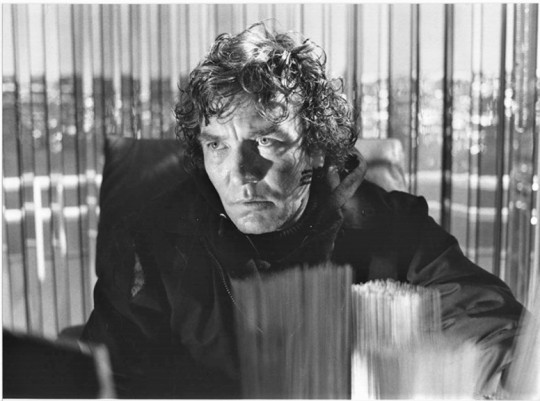
Were you ever offered another horror film on the strength of Wolfen?
Michael Wadleigh: A couple. As I recall, the offers were pretty serious. I’m told that Stephen King really liked Wolfen, though I don’t recall that I ever talked to him, but there were a number of inquiries made. It never came to a script being sent out, because I always said, “I’m just not interested.” Stephen personally got someone to phone me, and then I was going to see him in Maine-I still have a house there to this day—but somehow we never met. Mike Medavoy immediately said, “Well, why don’t we do another horror film?” A number of other people did too. I turned them all down.
Would you welcome the opportunity to release a director’s cut of Wolfen today?
Michael Wadleigh: I wouldn’t know how to do it! It was so long ago that I don’t think it can be done. I would welcome a re-release as it is right now, because I think, as I gather you do, that it’s a hell of a film, no matter whether it was recut or not. It’s got a lot of innovative stuff in it, and beautiful photography and thrills and chills, and I think that people might be amazed at the success it could have.
SPECIAL EFFECTS/WOLFEN-VISION
When producers Rupert Hitzig and Alan King snapped up the rights to Whitley Striber’s shaggy wolf story back in 1978, they knew it would be difficult to translate the book’s unusual Wolfen point-of-view to the screen. In fact, when production on Orion Picture’s WOLFEN began back in October, 1979, the only thing that then-director Michael Wadleigh was certain of was that nothing about the so-called “alien vision” was certain.
But it’s doubtful that Hitzig, King or Wadleigh could have possibly conceived that their self-proclaimed “thinking man’s horror film” would still be mired in a expensive eleventh hour production launch just weeks before the scheduled release. Perhaps the most terrifying aspect of WOLFEN-at least to its makers-is that after 20 months, $15 million, four screenwriters, two directors and several special effects houses, crucial effects sequences remained incomplete. Just six weeks prior to its July 24 opening. a topnotch effects crew headed by STAR WARS alumnus Robbie Blalack-was still working frantically to complete WOLFEN’S opticals on time.
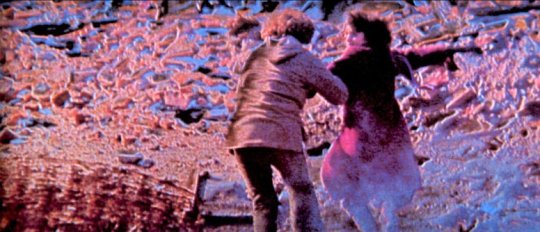
“We knew from the outset that filming the Wolfen point-of-view, or ‘alienvision’ as we call it, was going to be one elusive son of a gun,” said Rupert Hitzig during a break from a musical scoring session. “Nobody really went in with a master plan as to how to shoot the thing in a way that would give us complete manipulative editing and color control. Let’s just say that the whole thing has been at a great cost to my sanity, my family life and certainly my pocketbook.”
In preproduction, WOLFEN’S producers authorized a tidy $80,000 in seed money to effects houses on both coasts for generating footage that would approximate how the extraordinarily intelligent and sensorial-tuned Wolfen perceived the world.

“When we started, we had a technical consultant who we assumed knew what he was talking about,” Hitzig said. “We were assured that they had this phenomenal new computer printout device with the capacity to generate 235 different shades of grey. Well, I found that astronomical amounts of money for start-up and programming were being asked for without anyone being willing to prove that it actually could be done! We wanted to do things that had never been done before on straight optical printers, but the footage looked all grey and colors fell off into nothingness. So we shut it down, looked around and went with Blalack’s company, Praxis.”
Praxis is among the new crop of small, sophisticated special effects houses that have sprung up in recent years. Blalack, who set up the shop after splitting with former partner Jamie Shourt, first met with Wadleigh and Hitzig in August, 1980, and was given ten weeks to show the producers what they could do. “I showed them ten years of work,” Blalack said, “right through to STAR WARS. At that point, Michael and Rupert were fairly specific about what they were after, but they were extraordinarily open to our input.”
Praxis was originally hired for three months of work, but due to several changes in concept and personnel-most important the replacement of Wadleigh with John Hancock late in 1980-they worked on WOLFEN for fully nine months. “They have tremendous fiscal responsibility and concern, and they’re crealive,” said Hitzig of Blalack and his crew. “Frankly, it was a welcome breath of fresh air.”
The first “alienvision” technique that Praxis explored was “smell-o-vision,” a Michael Wadleigh brainchild that centered on the Wolfen’s ability to sniff out their prey. “Since we obviously couldn’t hand out sniff cards to audiences, we tried to convey the idea that the Wolfen could snifftranslation: see-images of dozens of people who had recently passed through a particular setting,” explained Praxis’ optical supervisor Beth Block. “The Wolfen would sift through these images and seize on the person they’re tracking. The backgrounds would always be visible through and behind the rapidly moving images of extraneous people. When the Wolfen locate the person, the image would lock in and become intensely focused.”
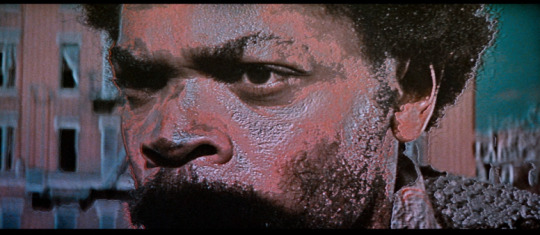
“To show their sense of smell, we used ghosted images. For example, when clues lead Wilson to the South Bronx, the Wolfen see him and make the connection that he’s on their trail. After he’s gone, they go to the spot where he parked his car. We see a series of ghosted images of things that have been there in the past: people, automobiles … That’s indicative of the smells that have been left behind. After all, smells are just molecules.”
Wadleigh’s “point of view shots” and “ghosted images” are bound to confuse audiences. “What can I say?” admits Director Wadleigh. “At first, it will be confusing, but I think it will sort itself out. People will go with it and not understand what it is until one of the characters explains it in the movie. It’ll be a healthy ambiguity. In my humble estimation, filmmakers don’t try enough interesting ideas.”
The “smell-o-vision” effects involved ghost-printing black and white figures over a color background. Though promising, the technique proved a backbreaker, since shots lasting only five to ten seconds were so image-dense that they required the equivalent of five minutes of film. “Smell-o-vision’ was a good idea, but the footage never really proved clear enough from an audience’s standpoint,” Beth Block explained “It just looked flashy.” When Michael Wadleigh exited WOLFEN “for political reasons” (the exact reasons are still unclear), “smell-o-vision” breathed its last.

Praxis next began work on a suitable means of achieving the Wollen’s night vision, which is used to hunt their human prey. After rejecting footage simply shot night-for-night, Blalack began experimenting with the use of false color and color substitution. The results, according to those who saw the early tests, were judged phenomenal,” but it was decided that it looked too phenomenal for the film’s purposes.
“To this day, Robbie probably disagrees with the choices that have been made,” Hitzig explained. “I know he would just as soon have had a strawberry-pink sky and shimmering iridescent lights-gorgeous stuff-but it certainly placed the Wolfen at a distance from the poor mortal viewing the film. Blalack wanted to place the Wolfen’s sensory capacities in a world of utopian color. Orion Pictures and I just felt the footage was too radical a departure from normal vision. It was particularly jarring in the number of cuts we have that shift from objective camera to ‘alienvision.’ We held that the juxtaposition would distance the audience’s subconscious identification with the Wolfen, and in turn, with the picture itself. Obviously, that was something we did not want to do.”

The rejection of the color replacement technique was a huge disappointment for Blalack and his crew, who felt they had come up with a truly startling visual scheme. “It was beautiful. It was really something special,” said Beth Block. “But did it approximate the way the Wolfen see? Maybe not. So we went with another approach that audiences could relate to, was filmically exciting and that worked within the story context. We realized that though some effects may seem old hat to us, they’re not to most movie audiences. And you don’t do effects to show off for other optical houses.”
The final “alienvision” design is still startling: a dark sky, a bright image and a sharp, jagged photographic outline on a figure in a color that signifies whether or not the Wolfen sees a human as prey. Blalack began with the assumption that the Wolfen could sense different emotional states as various colors; anger, fear and aggression would all be visibly different.
To properly isolate the desired foreground elements from the rest of the footage– which was shot without consideration to post production needs-contrast separations were frequently used, a technique also used in ALTERED STATES to add opticals to conventionally photographed footage. Using a wide range of film stocks and filters at various contrast levels, Beth Block was able to separate the flesh tones in a particular shot, alter it to taste, and recombine the footage to good effect. For several sequences, it was necessary to rotoscope the desired areas of the frame, a tedious chore handled by artist Pete Von Sholly.
youtube
Optical work was also required to enhance the actual look of the Wolfen. “At one point, Michael and I considered using midgets with masks.” Hitzig said, “but that would have undermined the allegorical feel we were after and take the picture into the realm of the grotesque. It’s true we were both anxious not to lay any of the Wolfen’s attributes to real wolves, a species that’s already pretty maligned. But in the end, we decided to go with real wolves, doctoring them to be totally black. I also felt strongly that Robbie and his crew should work on giving the Wolfen a light energy-an aura, almost-that separates them from looking like normal wolves.”
Praxis began experimenting on this “aura” in May, 1981, using new footage of the beasts that had been reshot by John Hancock. One option Praxis developed, dubbed the “searchlight mode,” involved shooting two beams of light against a black velvet drop, and then superimposing that onto the footage. The result, according to many at Praxis, was as nerve jangling as a lighthouse. Another attempt had animators tinting the eyes of the animals a violent blue, The “ole blue eyes” approach was torpedoed too, as were experiments with pinpoint lasers, which gave the Wolfen a semi-intentional VILLAGE OF THE DAMNED look. Eventually, Blalack, Hitzig and Hancock agreed on a white, milky glow of filaments around the Wolfen’s orbs, accomplished by tedious rotoscoping that was finally completed just five weeks before the film opened nationally.
Wolf Attacks/Make Up Effects
WOLFEN’s makeup effects also went through several major changes during the course of filming, contributing to the film’s expense and delay. Makeup artist Carl Fullerton had signed up on the project back in the summer of 1979, having just completed a stint on ALTERED STATES assisting Dick Smith. But when Orion Pictures ordered a halt to principal photography in February, 1980, several makeup effects had yet to be filmed and several others had to be rushed to completion.
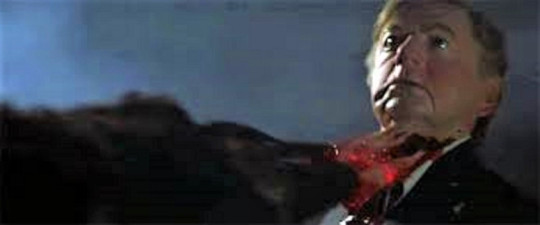
“Although I was given plenty of time to generate and test the specific effects that were called for, two of the major effects were left until the last day of New York locations, so it was a rush job,” Fullerton explained. “I had to ship a lot of effects out to the West Coast and wasn’t there to supervise that shooting. Initially the word was that the horror and gore were going to be soft-peddled, so they left that for the last thing to be shot. Later the approach changed so the shock stuff was in demand again.”
Fullerton, who had yet to see a final cut of the film at the time of his interview, had many lengthy meetings with Wadleigh to discuss the specific effects required. “Unlike many directors who never tell you what they’re after until they’re ready to shoot, Michael would sketch ideas on paper. He wanted to do things that had never been done on camera, and he made that process so much more open.”

Early in the film, the Wolfen murder two wealthy New Yorkers, Christopher and Pauline Vandervere (Max Brown and Ann Marie Pahtako) in New York City’s Battery Park. “Michael didn’t want the audience to fully see the creatures or to see that they were actually ripping out their victim’s throats,” Fullerton said. “He decided just to show blood dribbling from the man’s mouth. I wasn’t pleased with that. Not only was it boring and a cliche, it isn’t medically feasible.”
Instead, Fullerton suggested-and Wadleigh adopted-a spurting flow of blood from actor Max Brown’s mouth. “Dick Smith gave me some helpful advice,” Fullerton said, adding that the effect was somewhat similar to Smith’s torrent of pea soup in THE EXORCIST. “Smith suggested I attach a denture clip into the actor’s mouth, then attach tubing to it. I later found a way to actually direct the blood flow.” The tubing came up the back of the neck under Brown’s hair, over his cheek and into the corners of his mouth. Latex appliances camouflaged the mechanics. To film blood flowing from Brown’s nose, Fullerton had him lie down on a large platform to which a camera had been attached. The platform could tilt up and down like a teeter-totter, but the camera would see no such movement. Open-ended blood capsules were inserted into Brown’s nostrils while his head was near the ground; when the platform was tilted upwards, gravity caused the blood to flow realistically.
The script also called for the Wolfen to tear the hand off of Syad (John McCurry), the Vandervere’s Haitian bodyguard. When a false arm proved impractical, Fullerton devised a clever, on-camera effect. “We had the actor reach into his jacket with his own hand, grabbing for a gun in a shoulder strap,” he said. *The camera point-of-view is a wolf charging at him and the actor aims the gun at the ‘wolf.’ Meanwhile, something from the left side of the screen pushes into him and knocks his hand out of the frame. While out of view, I clipped an appliance over his arm-a flexible fiberglass stump spewing blood on his face and upper chest. We avoided a cutaway and the man ostensibly loses his hand on camera.”
This slideshow requires JavaScript.
More grisly effects were required for the death of a derelict named Mule, whose throat is ripped out by the Wolfen. It was one of several makeup sequences designed by Fullerton but shot during post production in Los Angeles because of his commitments on EYEWITNESS and FRIDAY THE 13TH-PART II. Unlike simple wounds, ripping out a throat required an appliance with substantial depth to it. Fullerton conducted extensive tests on himself before developing an appliance built up with fiberglass, epoxy and latex. “I actually remade the neck area.” Fullerton said. “The appliance fits under the jawline to simulate the whole neck and upper chest area. It had to allow the performer plenty of facial and body mobility-his only limitation would be really fast movements. The appliance was strapped to the actor’s chest and carefully glued to the lower jaw and neck.
“I have to say it was more successful on me,” Fullerton added. “I have a stronger jawline than the actor used in the scene.”
But the most demanding makeup assignment of all involved the Wolfen’s bold decapitation of a New York police commissioner (Dick O’Neill) in the middle of Wall Street. Although most of the sequence had been filmed on location in the financial district, the closeup of the Wolfen attack was to be shot in the studio. Though it’s a key sequence, it was left for the last day of shooting.
“Since there was really no other way to do the scene, I built a dummy head.” Fullerton said, “But a rigid dummy head would look just terrible if it wasn’t animated.” To provide the needed movement, Fullerton built a flexible neck out of gelatin and supported the head with an aluminum rod connected to a universal joint. The mouth was able to open and close, and a simple flick of the wrist on a control handle allowed an operator to move the head realistically in any number of ways.
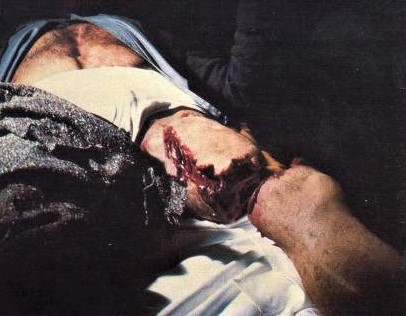
But problems arose when Fullerton’s dummy head met Eoin Sprott’s puppet wolf: it was difficult to get the wolf to attack both on target and at the proper speed. After several unsuccessful attempts, the plan was scrapped and Fullerton was forced to devise a solution on the spot, since filming had to wrap that day.
“Originally, Michael did not want a decapitation,” Fullerton said, “he just wanted to see the neck being bitten off and pushed out in front of the camera. After doing a shot, Michael decided that he wanted to change it and have a decapitation, but the dummy wasn’t built for that. So we had to do some surgery on it: open up the back of the neck, cut the whole supporting structure out and resupport it using a tongue depressor! The neck was prescored and had piano wires at the base of the skull. We had Eoin Sprott’s puppet head lunge at the neck of the dummy. At that point, I whirled the head off!”
youtube
In addition to filming the complex decapitation on the last, hectic day, Fullerton also set up and filmed an insert shot of Dick O’Neill poking his head through a section of fake pavement and rolling his eyes. In addition, the bloody death of Christopher Vandevere was also shot in that same day. But other planned effects could not be squeezed in and were executed in post production by makeup artist Allen Weisinger: the ripping out of the vagrant’s throat, described above; a close-up of John McCurry’s severed hand lying on the ground, the fingers twitching and still clutching the gun, achieved by having an actor stick his hand through a section of fake pavement and adding a latex stump; and a shot of Dick O’Neill’s head flying through the air spewing blood from its nose and mouth, achieved with a false head with built in canisters of stage blood and compressed air that was literally tossed up and down for the camera.
“The terrific thing was working with Michael,” Fullerton said. “But I have to admit that the pressure of doing everything at the last minute made it pretty frustrating. I can’t wait to see the movie, though, to see what got left in and what got left out.”
New York as one of the films Main Characters (Great Article @ NYC In Film about NY during the production of Wolfen)

PROMOTIONAL/ADVERTISING
youtube
This slideshow requires JavaScript.
SCORE/SOUNDTRACK
Wolfen (1981) The Unused Score by Craig Safan
youtube
Composer Craig Safan wrote an original score for this film and was replaced at the last minute by future Academy Award winner James Horner, who had only 12 days to write and record his score.
youtube
CAST/CREW
Directed
Michael Wadleigh
Produced
Rupert Hitzig
Screenplay
David M. Eyre, Jr.
Michael Wadleigh
Uncredited:Eric Roth
Story by
David M. Eyre, Jr.
Michael Wadleigh
Based on
The Wolfen
by Whitley Strieber
Albert Finney as Dewey Wilson
Diane Venora as Rebecca Neff
Edward James Olmos as Eddie Holt
Gregory Hines as Whittington
Tom Noonan as Ferguson
Dick O’Neill as Warren
Dehl Berti as Old Indian
Peter Michael Goetz as Ross
Reginald VelJohnson as Morgue Attendant
James Tolkan as Baldy
Donald Symington as Lawyer
Tom Waits as Drunken Bar Owner (uncredited)
Makeup Department
Frank Bianco
Carl Fullerton
Allen Weisinger
Michael R. Thomas
CREDITS/REFERENCES/SOURCES/BIBLIOGRAPHY
Cinefantastique V11n03
Fangoria#028
Fangoria#013
Fangoria#301
Thanks to Mark E. [email protected] for allowing me to link his great informative article on old school NY.
Wolfen (1981) Retrospective SUMMARY Former NYPD Captain Dewey Wilson is brought back to the force and assigned to solve a bizarre string of violent murders after high-profile magnate Christopher Van der Veer, his wife and his bodyguard are slain in Battery Park.
0 notes
Photo
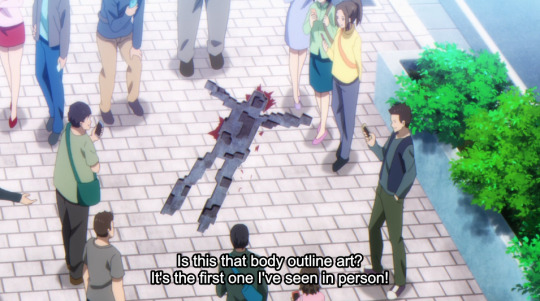



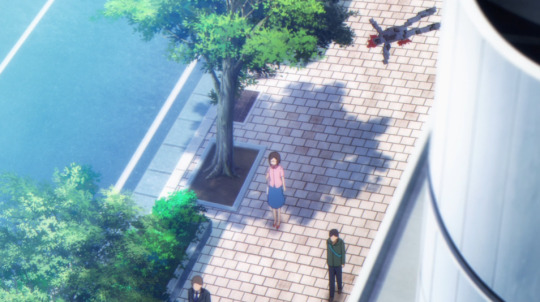
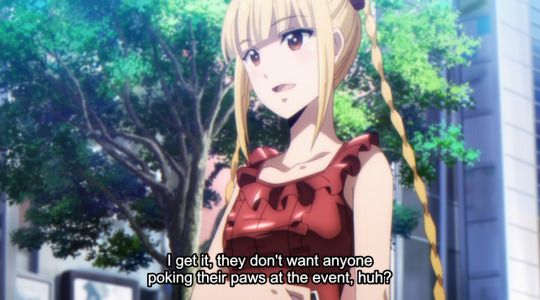
I guess the severe logistical issue of the public witnessing hundreds of people engage in a game where they kill each other had to be “resolved” eventually, but it’s extremely lame either way.
I would much rather see these people have to desperately use stealth to defeat their opponents so they themselves don’t die, and also contend with law enforcement, civilian casualties, and witnesses instead of just existing in a Magic Awareness Bubble. You want superpowered people to fight each other in public deathmatches, but you don’t want to address or incorporate the consequences of doing those things in public... so why is it even set up like this?
#:Darwin's Game#darwin's game#like. they could be forced to go to selected isolated areas to fight. the stakes would be The Same
0 notes